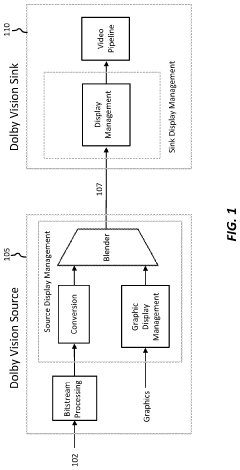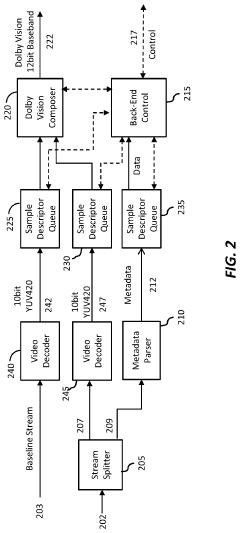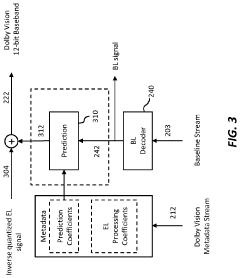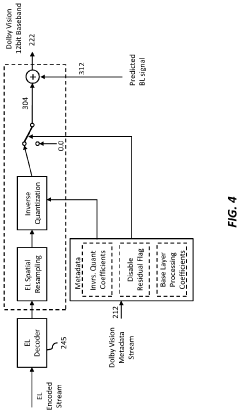Leveraging Dolby Vision for Enhanced Marketing Campaigns
JUL 30, 20259 MIN READ
Generate Your Research Report Instantly with AI Agent
Patsnap Eureka helps you evaluate technical feasibility & market potential.
Dolby Vision Evolution
Dolby Vision has undergone a remarkable evolution since its inception, transforming the landscape of visual technology and marketing campaigns. Initially introduced in 2014, Dolby Vision was primarily focused on enhancing the viewing experience in high-end televisions and cinema screens. The technology aimed to deliver superior image quality by optimizing brightness, contrast, and color accuracy.
As the technology matured, Dolby Vision expanded its reach beyond traditional entertainment platforms. By 2016, it had made significant inroads into mobile devices, with smartphones and tablets incorporating Dolby Vision capabilities. This expansion marked a crucial turning point, as it opened up new possibilities for marketers to leverage high-quality visual content across a wider range of consumer devices.
The evolution of Dolby Vision also saw advancements in content creation tools and workflows. Between 2017 and 2019, Dolby introduced professional-grade software and hardware solutions that enabled content creators to produce and edit Dolby Vision-compatible material more efficiently. This development facilitated the production of marketing content that could fully utilize the technology's capabilities, resulting in more visually striking and impactful campaigns.
In recent years, Dolby Vision has further evolved to address the growing demand for immersive experiences in various sectors. The technology has been adapted for use in virtual and augmented reality applications, offering marketers new avenues to create engaging and interactive promotional content. This expansion has allowed brands to develop more innovative and memorable marketing campaigns that leverage the full potential of Dolby Vision's enhanced visual fidelity.
The most recent phase of Dolby Vision's evolution has focused on integration with artificial intelligence and machine learning technologies. This integration has led to more sophisticated content optimization algorithms, enabling real-time adjustments to visual content based on viewing conditions and device capabilities. For marketers, this means that their Dolby Vision-enhanced campaigns can now adapt dynamically to deliver the best possible visual experience across a diverse range of viewing environments and devices.
As Dolby Vision continues to evolve, it is increasingly becoming a powerful tool for marketers seeking to create visually stunning and emotionally resonant campaigns. The technology's ongoing development promises to open up new creative possibilities and enhance the effectiveness of visual marketing strategies across various platforms and mediums.
As the technology matured, Dolby Vision expanded its reach beyond traditional entertainment platforms. By 2016, it had made significant inroads into mobile devices, with smartphones and tablets incorporating Dolby Vision capabilities. This expansion marked a crucial turning point, as it opened up new possibilities for marketers to leverage high-quality visual content across a wider range of consumer devices.
The evolution of Dolby Vision also saw advancements in content creation tools and workflows. Between 2017 and 2019, Dolby introduced professional-grade software and hardware solutions that enabled content creators to produce and edit Dolby Vision-compatible material more efficiently. This development facilitated the production of marketing content that could fully utilize the technology's capabilities, resulting in more visually striking and impactful campaigns.
In recent years, Dolby Vision has further evolved to address the growing demand for immersive experiences in various sectors. The technology has been adapted for use in virtual and augmented reality applications, offering marketers new avenues to create engaging and interactive promotional content. This expansion has allowed brands to develop more innovative and memorable marketing campaigns that leverage the full potential of Dolby Vision's enhanced visual fidelity.
The most recent phase of Dolby Vision's evolution has focused on integration with artificial intelligence and machine learning technologies. This integration has led to more sophisticated content optimization algorithms, enabling real-time adjustments to visual content based on viewing conditions and device capabilities. For marketers, this means that their Dolby Vision-enhanced campaigns can now adapt dynamically to deliver the best possible visual experience across a diverse range of viewing environments and devices.
As Dolby Vision continues to evolve, it is increasingly becoming a powerful tool for marketers seeking to create visually stunning and emotionally resonant campaigns. The technology's ongoing development promises to open up new creative possibilities and enhance the effectiveness of visual marketing strategies across various platforms and mediums.
Market Demand Analysis
The market demand for Dolby Vision in marketing campaigns has been steadily increasing as brands seek to differentiate themselves in an increasingly competitive digital landscape. This advanced HDR technology offers superior image quality, enhanced color depth, and improved contrast, making it an attractive option for marketers looking to create visually stunning and impactful campaigns.
Consumer expectations for high-quality visual content have risen dramatically in recent years, driven by the proliferation of 4K and HDR-capable devices. This trend has created a significant opportunity for brands to leverage Dolby Vision technology in their marketing efforts. The technology's ability to deliver more vibrant and lifelike images aligns perfectly with the growing demand for immersive and engaging content across various platforms, including social media, streaming services, and digital billboards.
The adoption of Dolby Vision in marketing campaigns has been particularly strong in industries where visual appeal is crucial, such as automotive, fashion, and luxury goods. These sectors have recognized the technology's potential to showcase their products in the best possible light, literally and figuratively. For example, automotive brands have used Dolby Vision to highlight the sleek lines and intricate details of their vehicles, resulting in more compelling and persuasive marketing materials.
E-commerce platforms have also shown increasing interest in Dolby Vision, as it allows for more accurate product representation. This enhanced visual fidelity can lead to higher customer satisfaction and potentially reduce return rates, addressing a significant pain point in online retail. The technology's ability to render colors and textures more accurately is especially valuable for fashion and beauty brands, where product appearance is a critical factor in purchasing decisions.
The entertainment and media industries have been early adopters of Dolby Vision in their promotional content. Movie studios and streaming services have leveraged the technology to create eye-catching trailers and advertisements that stand out in crowded digital spaces. This has set a new standard for visual quality in marketing, influencing other sectors to follow suit.
As mobile devices increasingly support Dolby Vision, the potential market for this technology in marketing campaigns has expanded significantly. With consumers spending more time on their smartphones and tablets, brands are recognizing the importance of delivering high-quality visual experiences on these platforms. This trend is likely to drive further adoption of Dolby Vision in mobile-first marketing strategies.
The growing emphasis on video content in digital marketing strategies aligns well with the capabilities of Dolby Vision. As video continues to dominate social media feeds and digital advertising spaces, the demand for technologies that can enhance video quality and engagement is expected to rise. Dolby Vision's ability to improve the visual impact of video content makes it a valuable tool for marketers looking to capture and retain audience attention in a crowded digital environment.
Consumer expectations for high-quality visual content have risen dramatically in recent years, driven by the proliferation of 4K and HDR-capable devices. This trend has created a significant opportunity for brands to leverage Dolby Vision technology in their marketing efforts. The technology's ability to deliver more vibrant and lifelike images aligns perfectly with the growing demand for immersive and engaging content across various platforms, including social media, streaming services, and digital billboards.
The adoption of Dolby Vision in marketing campaigns has been particularly strong in industries where visual appeal is crucial, such as automotive, fashion, and luxury goods. These sectors have recognized the technology's potential to showcase their products in the best possible light, literally and figuratively. For example, automotive brands have used Dolby Vision to highlight the sleek lines and intricate details of their vehicles, resulting in more compelling and persuasive marketing materials.
E-commerce platforms have also shown increasing interest in Dolby Vision, as it allows for more accurate product representation. This enhanced visual fidelity can lead to higher customer satisfaction and potentially reduce return rates, addressing a significant pain point in online retail. The technology's ability to render colors and textures more accurately is especially valuable for fashion and beauty brands, where product appearance is a critical factor in purchasing decisions.
The entertainment and media industries have been early adopters of Dolby Vision in their promotional content. Movie studios and streaming services have leveraged the technology to create eye-catching trailers and advertisements that stand out in crowded digital spaces. This has set a new standard for visual quality in marketing, influencing other sectors to follow suit.
As mobile devices increasingly support Dolby Vision, the potential market for this technology in marketing campaigns has expanded significantly. With consumers spending more time on their smartphones and tablets, brands are recognizing the importance of delivering high-quality visual experiences on these platforms. This trend is likely to drive further adoption of Dolby Vision in mobile-first marketing strategies.
The growing emphasis on video content in digital marketing strategies aligns well with the capabilities of Dolby Vision. As video continues to dominate social media feeds and digital advertising spaces, the demand for technologies that can enhance video quality and engagement is expected to rise. Dolby Vision's ability to improve the visual impact of video content makes it a valuable tool for marketers looking to capture and retain audience attention in a crowded digital environment.
Technical Challenges
Implementing Dolby Vision for marketing campaigns presents several technical challenges that need to be addressed. One of the primary obstacles is the requirement for specialized hardware and software capable of capturing, processing, and displaying Dolby Vision content. This technology demands high-dynamic-range (HDR) cameras, advanced color grading tools, and compatible displays, which may not be readily available or affordable for all marketing teams.
Another significant challenge lies in the complexity of the Dolby Vision workflow. The process involves intricate color grading and metadata management, requiring skilled technicians and colorists who are proficient in working with this advanced HDR format. This expertise is not widespread in the marketing industry, potentially limiting the adoption and effective utilization of Dolby Vision in campaigns.
Content distribution poses yet another hurdle. While Dolby Vision is gaining traction, not all platforms and devices support this format. Marketers must consider the fragmented ecosystem of consumer devices and ensure their content is accessible across various platforms, which may necessitate creating multiple versions of the same content to cater to different display capabilities.
The file size and bandwidth requirements for Dolby Vision content present additional technical challenges. The enhanced color and brightness information results in larger file sizes compared to standard dynamic range (SDR) content. This can impact streaming performance and storage needs, potentially increasing costs and complexity for marketing teams managing and delivering campaigns.
Ensuring consistency across different viewing environments is also a significant technical challenge. Dolby Vision content may appear differently on various displays, from high-end TVs to mobile devices, making it difficult to maintain a uniform brand message and visual experience across all platforms. This variability requires extensive testing and optimization to ensure the intended visual impact is preserved across diverse viewing scenarios.
Moreover, the integration of Dolby Vision into existing marketing workflows and content management systems can be complex. Many current systems may not be designed to handle the specific metadata and processing requirements of Dolby Vision, necessitating upgrades or the development of new tools and processes to seamlessly incorporate this technology into marketing operations.
Lastly, the rapid evolution of display technologies and standards presents an ongoing challenge. As new HDR formats and improvements emerge, marketing teams must stay abreast of these developments and potentially adapt their Dolby Vision content to remain compatible with future display technologies, ensuring the longevity and relevance of their marketing assets.
Another significant challenge lies in the complexity of the Dolby Vision workflow. The process involves intricate color grading and metadata management, requiring skilled technicians and colorists who are proficient in working with this advanced HDR format. This expertise is not widespread in the marketing industry, potentially limiting the adoption and effective utilization of Dolby Vision in campaigns.
Content distribution poses yet another hurdle. While Dolby Vision is gaining traction, not all platforms and devices support this format. Marketers must consider the fragmented ecosystem of consumer devices and ensure their content is accessible across various platforms, which may necessitate creating multiple versions of the same content to cater to different display capabilities.
The file size and bandwidth requirements for Dolby Vision content present additional technical challenges. The enhanced color and brightness information results in larger file sizes compared to standard dynamic range (SDR) content. This can impact streaming performance and storage needs, potentially increasing costs and complexity for marketing teams managing and delivering campaigns.
Ensuring consistency across different viewing environments is also a significant technical challenge. Dolby Vision content may appear differently on various displays, from high-end TVs to mobile devices, making it difficult to maintain a uniform brand message and visual experience across all platforms. This variability requires extensive testing and optimization to ensure the intended visual impact is preserved across diverse viewing scenarios.
Moreover, the integration of Dolby Vision into existing marketing workflows and content management systems can be complex. Many current systems may not be designed to handle the specific metadata and processing requirements of Dolby Vision, necessitating upgrades or the development of new tools and processes to seamlessly incorporate this technology into marketing operations.
Lastly, the rapid evolution of display technologies and standards presents an ongoing challenge. As new HDR formats and improvements emerge, marketing teams must stay abreast of these developments and potentially adapt their Dolby Vision content to remain compatible with future display technologies, ensuring the longevity and relevance of their marketing assets.
Current Implementation
01 Display technology for enhanced visual experience
Dolby Vision is an advanced display technology that enhances the visual experience by improving color, contrast, and brightness. It utilizes high dynamic range (HDR) imaging to provide a more lifelike and immersive viewing experience across various devices, including televisions, monitors, and mobile screens.- Display technology for enhanced image quality: Dolby Vision is an advanced display technology that enhances image quality by improving contrast, brightness, and color accuracy. It utilizes high dynamic range (HDR) and wide color gamut techniques to deliver more lifelike and immersive visual experiences across various display devices.
- Audio-visual synchronization and processing: The technology incorporates sophisticated audio-visual synchronization and processing methods to ensure seamless integration of high-quality video and audio. This includes techniques for managing audio delay, enhancing sound quality, and optimizing the overall viewing experience.
- Content creation and mastering tools: Dolby Vision provides content creators with advanced tools and workflows for mastering and producing HDR content. These tools enable precise control over color grading, brightness levels, and dynamic range, allowing for consistent and high-quality content across different display devices.
- Adaptive optimization for various displays: The technology incorporates adaptive optimization algorithms that adjust content based on the capabilities of different display devices. This ensures that viewers experience the best possible image quality regardless of the specific hardware they are using, from high-end televisions to mobile devices.
- Integration with other multimedia technologies: Dolby Vision is designed to integrate seamlessly with other multimedia technologies and standards. This includes compatibility with various video codecs, streaming platforms, and content delivery systems, ensuring a wide-ranging application across the entertainment and media industry.
02 Audio-visual synchronization and processing
The technology incorporates sophisticated audio-visual synchronization and processing techniques to ensure seamless integration of high-quality video and audio. This includes methods for encoding, decoding, and transmitting audio-visual data to maintain the integrity of the Dolby Vision experience across different platforms and devices.Expand Specific Solutions03 Content creation and mastering tools
Dolby Vision provides content creators with advanced tools and workflows for mastering and producing high-quality HDR content. These tools enable precise control over color grading, brightness levels, and dynamic range, allowing creators to achieve their artistic vision and deliver consistent results across various display devices.Expand Specific Solutions04 Adaptive optimization for different displays
The technology incorporates adaptive optimization algorithms that adjust content based on the capabilities of individual display devices. This ensures that viewers experience the best possible image quality regardless of the specific hardware they are using, by dynamically adapting brightness, contrast, and color to suit each display's characteristics.Expand Specific Solutions05 Integration with other audio-visual technologies
Dolby Vision is designed to work in conjunction with other audio and visual technologies, such as Dolby Atmos for immersive sound. This integration allows for a comprehensive and enhanced entertainment experience, combining superior video quality with advanced audio capabilities across various media platforms and devices.Expand Specific Solutions
Key Industry Players
The market for leveraging Dolby Vision in marketing campaigns is in its growth phase, with increasing adoption across various industries. The global market size for high-dynamic-range (HDR) imaging, including Dolby Vision, is projected to expand significantly in the coming years. Technologically, Dolby Vision is mature, but its application in marketing is still evolving. Key players like Dolby Laboratories Licensing Corp., Sony Interactive Entertainment, and Roku, Inc. are at the forefront of this technology's implementation. Companies such as Google LLC and Microsoft Technology Licensing LLC are also exploring innovative ways to integrate Dolby Vision into their marketing strategies, indicating a competitive and dynamic landscape.
Dolby Laboratories Licensing Corp.
Technical Solution: Dolby Laboratories has developed a comprehensive Dolby Vision ecosystem for enhanced marketing campaigns. Their technology enables content creators to produce high dynamic range (HDR) content with increased brightness, contrast, and color accuracy. Dolby Vision's advanced algorithms optimize content for various display capabilities, ensuring consistent quality across devices[1]. The company has also introduced Dolby Vision IQ, which adapts content based on ambient light conditions, enhancing viewing experiences in diverse environments[2]. For marketing campaigns, Dolby Vision offers tools for creating immersive product demonstrations, virtual showrooms, and interactive advertisements that showcase products in their best light, literally and figuratively[3].
Strengths: Industry-leading HDR technology, wide ecosystem support, adaptive viewing experiences. Weaknesses: Requires compatible hardware, potential licensing costs for marketers.
Sony Group Corp.
Technical Solution: Sony has integrated Dolby Vision technology into its marketing strategies, particularly for its high-end BRAVIA TVs and PlayStation consoles. The company leverages Dolby Vision to showcase the superior picture quality of its products in retail environments and online demonstrations. Sony's approach includes creating Dolby Vision-optimized content for product launches, virtual tours of new technologies, and immersive brand experiences[4]. Additionally, Sony has developed its own image processing technologies, such as the X1 Ultimate processor, which works in tandem with Dolby Vision to enhance content quality further[5]. For marketing campaigns, Sony utilizes these technologies to create visually stunning advertisements and product comparisons that highlight the benefits of their Dolby Vision-compatible devices.
Strengths: Strong brand recognition, integration across multiple product lines, proprietary image enhancement technologies. Weaknesses: Reliance on third-party technology (Dolby Vision), potential for market saturation in high-end segments.
Core Dolby Patents
Layered representation and delivery of high dynamic range video
PatentActiveUS20190373290A1
Innovation
- The implementation of a layered representation and delivery system for HDR video, utilizing Dolby Vision technology, which includes a base layer and enhancement layer, along with metadata processing to reconstruct HDR signals, ensuring seamless playback on compatible displays.
Extended dynamic range and extended dimensionality image signal conversion
PatentWO2010104624A2
Innovation
- The implementation of a Visual Dynamic Range (VDR) format that maps HDR video signals into legacy interfaces like HDMI, DVI, and SDI, using a method that converts color components into device-independent color space values (LD, u', v') and quantizes them for efficient packaging within the constraints of these interfaces, allowing for transmission and rendering on both HDR and lower dynamic range displays.
Content Creation Tools
Content creation tools play a crucial role in leveraging Dolby Vision for enhanced marketing campaigns. These tools enable marketers and content creators to produce visually stunning and immersive content that fully utilizes the capabilities of Dolby Vision technology.
One of the primary content creation tools for Dolby Vision is the Dolby Vision Production Suite. This comprehensive software package includes tools for color grading, mastering, and quality control. It allows creators to fine-tune the high dynamic range (HDR) and wide color gamut aspects of their content, ensuring that it meets Dolby Vision standards and delivers an optimal viewing experience across various devices.
Adobe Creative Cloud applications, such as Premiere Pro and After Effects, have integrated Dolby Vision support, allowing creators to work with HDR content directly within their familiar editing environments. These integrations streamline the workflow for marketing teams, enabling them to create and edit Dolby Vision-compatible content without switching between multiple software platforms.
For on-set production, cameras capable of capturing Dolby Vision content are essential tools. Manufacturers like ARRI, RED, and Sony offer professional-grade cameras that can capture the wide dynamic range and color depth required for Dolby Vision content. These cameras, combined with on-set monitoring solutions, ensure that the visual quality is maintained from capture to post-production.
Color grading software like DaVinci Resolve and Baselight have also incorporated Dolby Vision workflows, providing powerful tools for colorists to enhance and optimize marketing content. These platforms offer precise control over the HDR image, allowing for the creation of visually striking and emotionally impactful marketing materials.
For web and mobile content, developers can utilize the Dolby Vision Web Tools. These include JavaScript libraries and APIs that enable the creation of Dolby Vision-compatible web experiences, ensuring that marketing campaigns maintain their visual impact across various online platforms and devices.
Virtual production tools, such as those used in LED wall environments, are increasingly incorporating Dolby Vision support. This allows marketers to create immersive, photorealistic backgrounds for product showcases and brand experiences, leveraging the technology's enhanced contrast and color capabilities.
As the adoption of Dolby Vision in marketing continues to grow, we can expect to see further development of specialized content creation tools. These may include AI-powered color grading assistants, real-time Dolby Vision preview tools for social media platforms, and more integrated solutions for creating and distributing Dolby Vision content across various marketing channels.
One of the primary content creation tools for Dolby Vision is the Dolby Vision Production Suite. This comprehensive software package includes tools for color grading, mastering, and quality control. It allows creators to fine-tune the high dynamic range (HDR) and wide color gamut aspects of their content, ensuring that it meets Dolby Vision standards and delivers an optimal viewing experience across various devices.
Adobe Creative Cloud applications, such as Premiere Pro and After Effects, have integrated Dolby Vision support, allowing creators to work with HDR content directly within their familiar editing environments. These integrations streamline the workflow for marketing teams, enabling them to create and edit Dolby Vision-compatible content without switching between multiple software platforms.
For on-set production, cameras capable of capturing Dolby Vision content are essential tools. Manufacturers like ARRI, RED, and Sony offer professional-grade cameras that can capture the wide dynamic range and color depth required for Dolby Vision content. These cameras, combined with on-set monitoring solutions, ensure that the visual quality is maintained from capture to post-production.
Color grading software like DaVinci Resolve and Baselight have also incorporated Dolby Vision workflows, providing powerful tools for colorists to enhance and optimize marketing content. These platforms offer precise control over the HDR image, allowing for the creation of visually striking and emotionally impactful marketing materials.
For web and mobile content, developers can utilize the Dolby Vision Web Tools. These include JavaScript libraries and APIs that enable the creation of Dolby Vision-compatible web experiences, ensuring that marketing campaigns maintain their visual impact across various online platforms and devices.
Virtual production tools, such as those used in LED wall environments, are increasingly incorporating Dolby Vision support. This allows marketers to create immersive, photorealistic backgrounds for product showcases and brand experiences, leveraging the technology's enhanced contrast and color capabilities.
As the adoption of Dolby Vision in marketing continues to grow, we can expect to see further development of specialized content creation tools. These may include AI-powered color grading assistants, real-time Dolby Vision preview tools for social media platforms, and more integrated solutions for creating and distributing Dolby Vision content across various marketing channels.
Consumer Perception
Consumer perception of Dolby Vision technology plays a crucial role in the success of marketing campaigns leveraging this advanced imaging format. Understanding how consumers perceive and respond to Dolby Vision content is essential for crafting effective marketing strategies and maximizing the impact of visual advertisements.
Research indicates that consumers generally associate Dolby Vision with premium visual experiences, often perceiving it as a mark of quality in televisions, streaming content, and cinema. This perception stems from the technology's ability to deliver enhanced contrast, brighter highlights, and a wider color gamut, resulting in more lifelike and immersive imagery.
When exposed to Dolby Vision content, consumers frequently report a heightened sense of realism and depth in the visuals. This increased engagement can lead to longer viewing times and stronger emotional connections with the content, making it particularly valuable for marketing campaigns aiming to create lasting impressions.
However, consumer awareness of Dolby Vision varies significantly across different demographics and regions. While tech-savvy consumers and early adopters are often familiar with the technology and actively seek it out, a substantial portion of the general public may not fully understand its benefits or differentiate it from other HDR formats.
Marketing campaigns utilizing Dolby Vision must consider this disparity in consumer knowledge. Educating viewers about the technology's advantages can be an effective strategy to increase appreciation and demand for Dolby Vision content. This approach can be particularly impactful in sectors such as luxury goods, travel, and automotive, where visual appeal is paramount.
Consumer studies have shown that Dolby Vision content can influence purchasing decisions, especially in the consumer electronics market. Televisions and mobile devices supporting Dolby Vision are often perceived as more desirable, with consumers willing to pay a premium for this feature. This perception extends to content platforms, with streaming services offering Dolby Vision titles viewed as providing superior value.
For marketers, leveraging Dolby Vision in campaigns presents both opportunities and challenges. While the technology can significantly enhance the visual impact of advertisements, it requires careful consideration of distribution channels to ensure the content is displayed as intended. Not all devices or platforms support Dolby Vision, potentially limiting reach or necessitating the creation of alternative versions for different display technologies.
In conclusion, consumer perception of Dolby Vision is generally positive, associating it with high-quality, immersive visual experiences. However, the varying levels of awareness and understanding among consumers highlight the need for targeted education and strategic deployment in marketing campaigns to fully capitalize on the technology's potential.
Research indicates that consumers generally associate Dolby Vision with premium visual experiences, often perceiving it as a mark of quality in televisions, streaming content, and cinema. This perception stems from the technology's ability to deliver enhanced contrast, brighter highlights, and a wider color gamut, resulting in more lifelike and immersive imagery.
When exposed to Dolby Vision content, consumers frequently report a heightened sense of realism and depth in the visuals. This increased engagement can lead to longer viewing times and stronger emotional connections with the content, making it particularly valuable for marketing campaigns aiming to create lasting impressions.
However, consumer awareness of Dolby Vision varies significantly across different demographics and regions. While tech-savvy consumers and early adopters are often familiar with the technology and actively seek it out, a substantial portion of the general public may not fully understand its benefits or differentiate it from other HDR formats.
Marketing campaigns utilizing Dolby Vision must consider this disparity in consumer knowledge. Educating viewers about the technology's advantages can be an effective strategy to increase appreciation and demand for Dolby Vision content. This approach can be particularly impactful in sectors such as luxury goods, travel, and automotive, where visual appeal is paramount.
Consumer studies have shown that Dolby Vision content can influence purchasing decisions, especially in the consumer electronics market. Televisions and mobile devices supporting Dolby Vision are often perceived as more desirable, with consumers willing to pay a premium for this feature. This perception extends to content platforms, with streaming services offering Dolby Vision titles viewed as providing superior value.
For marketers, leveraging Dolby Vision in campaigns presents both opportunities and challenges. While the technology can significantly enhance the visual impact of advertisements, it requires careful consideration of distribution channels to ensure the content is displayed as intended. Not all devices or platforms support Dolby Vision, potentially limiting reach or necessitating the creation of alternative versions for different display technologies.
In conclusion, consumer perception of Dolby Vision is generally positive, associating it with high-quality, immersive visual experiences. However, the varying levels of awareness and understanding among consumers highlight the need for targeted education and strategic deployment in marketing campaigns to fully capitalize on the technology's potential.
Unlock deeper insights with Patsnap Eureka Quick Research — get a full tech report to explore trends and direct your research. Try now!
Generate Your Research Report Instantly with AI Agent
Supercharge your innovation with Patsnap Eureka AI Agent Platform!







